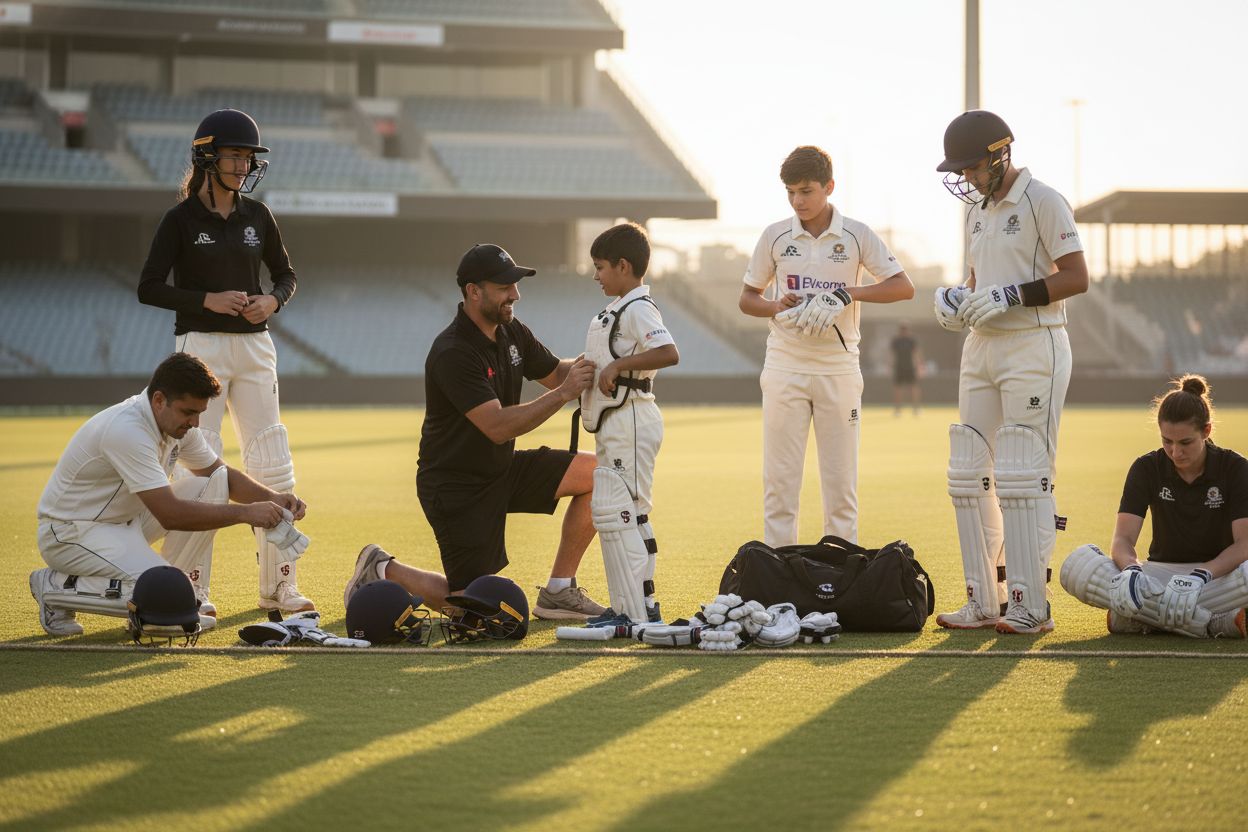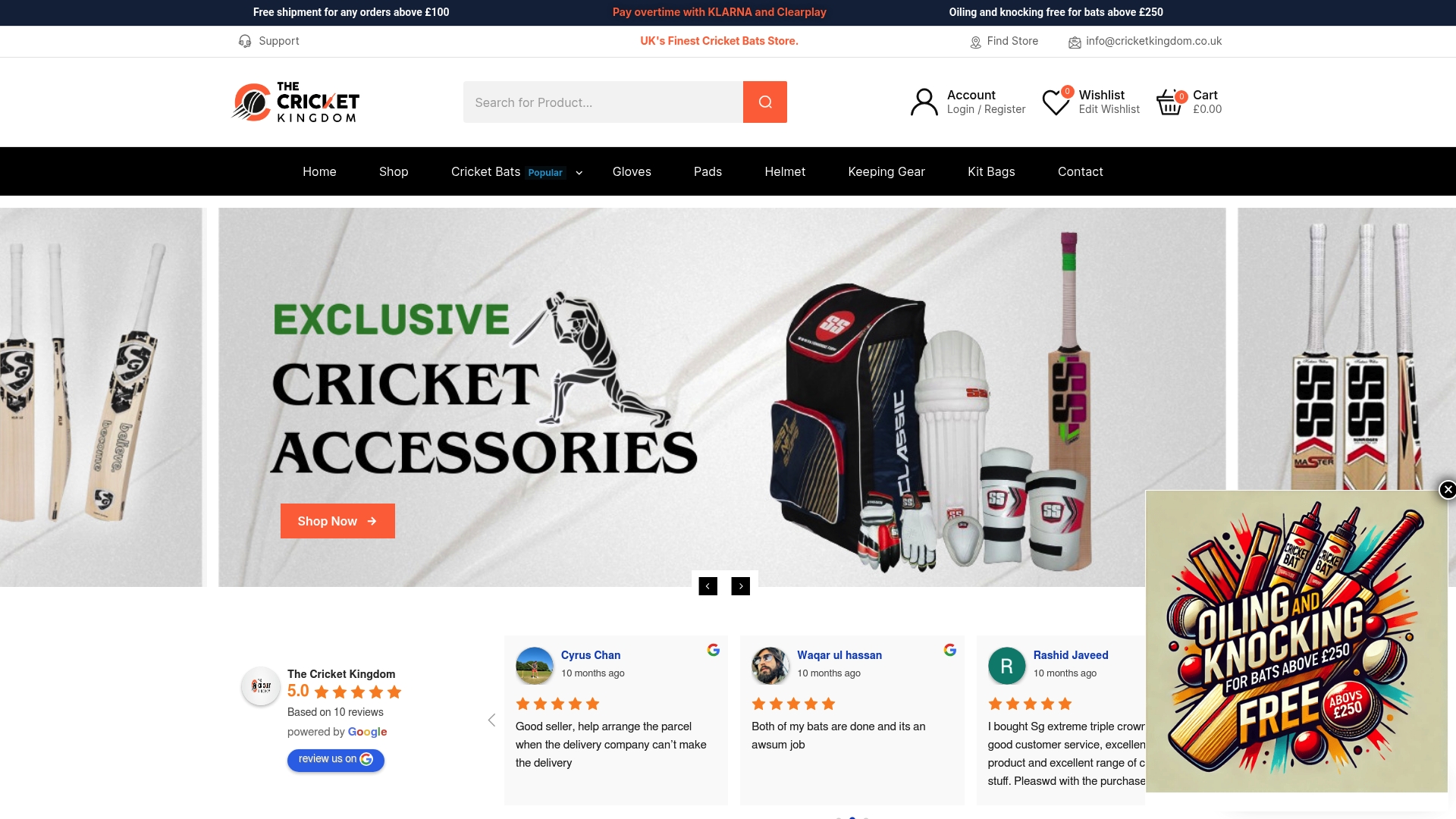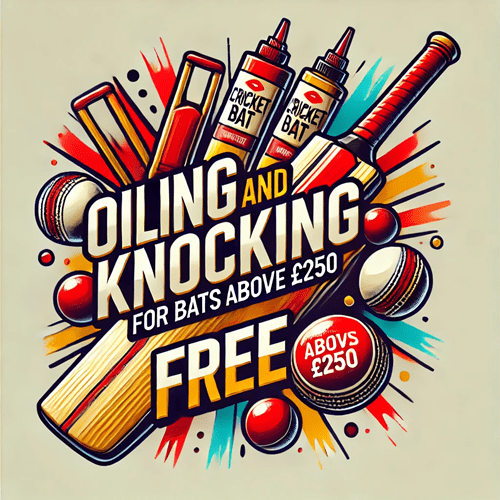7 Essential Examples of Protective Gear for Cricketers

Cricket may look elegant on the surface but the risks lurking on the pitch are real. Protective gear in cricket has helped cut serious injuries by up to 70 percent, according to global sports medicine research. Most people think a helmet or some pads are enough for safety but the real game changer comes from knowing exactly what gear keeps you protected and what can leave you exposed in a split second.
Table of Contents
- Introduction To Protective Gear In Cricket
- Importance Of Helmets For Batting Safety
- Role Of Pads In Protecting Legs During Play
- Benefits Of Chest Guards For Added Protection
- Why Use Protective Gloves While Batting And Fielding?
- The Significance Of Thigh Protectors For Batsmen
- Conclusion: Choosing The Right Protective Gear
Quick Summary
| Takeaway | Explanation |
|---|---|
| Invest in high-quality protective gear. | Quality gear significantly reduces injury risks and enhances player safety, making it essential for all cricket players. |
| Understand the specific protective needs per position. | Different roles require specialized gear; batters need helmets and pads, while bowlers may focus on gloves and thigh protectors. |
| Choose gear that fits comfortably and complies with safety standards. | Proper fitting and adherence to regulations ensure optimal protection without compromising mobility during gameplay. |
| Regularly assess and update your protective equipment. | Keeping up with advancements in safety technology can enhance protection and player confidence on the field. |
| Implement a multilayered protective strategy. | Combining various protective equipment types fortifies defense against injuries, offsetting limitations of individual items. |
1: Introduction to Protective Gear in Cricket
Cricket is a high-intensity sport where players face significant physical risks during gameplay. Protective gear plays a critical role in safeguarding players from potential injuries, particularly when facing fast-moving balls and intense physical interactions on the field. Understanding the essential examples of protective gear is crucial for any cricket player, from amateur enthusiasts to professional athletes.
The primary purpose of protective equipment is to minimize injury risks across multiple aspects of the game. Whether batting, bowling, or fielding, each player requires specialized protective gear tailored to their specific role and potential exposure to physical impacts. Our comprehensive cricket gear buying guide can help players understand the nuanced selection of protective equipment.
Key considerations for selecting protective gear include:
- Level of protection
- Comfort and flexibility
- Material quality
- Sport regulations compliance
- Individual player requirements
According to World Cricket Injury Prevention Research, cricket-related injuries can range from minor bruises to serious head and body traumas. By investing in high-quality protective equipment, players significantly reduce their risk of potential long-term health complications.
Modern cricket protective gear combines advanced materials like high-density foam, lightweight polymers, and impact-resistant composites to provide maximum safety without compromising player mobility. The evolution of protective technology has transformed how players approach personal safety on the cricket field, making contemporary gear far more effective than traditional equipment.
This article will explore seven essential examples of protective gear that every cricket player should consider, highlighting their specific functions, importance, and how they contribute to overall player safety and performance.
2: Importance of Helmets for Batting Safety
Head injuries represent one of the most serious risks in cricket, particularly during batting when players face high-velocity deliveries approaching speeds of 90 miles per hour. Helmets have transformed player safety, providing critical protection against potentially life-threatening impacts that could cause skull fractures, concussions, or severe neurological damage.
Understanding types of cricket helmets becomes crucial for players seeking comprehensive protection. Modern cricket helmets are engineered with advanced materials and design principles to absorb and distribute impact forces effectively.
Key protective features of cricket helmets include:
- Reinforced outer shell made from high-impact resistant polymers
- Shock-absorbing inner padding
- Adjustable chin straps for secure fitting
- Comprehensive coverage of skull and temporal regions
- Ventilation systems to prevent overheating
According to International Cricket Safety Research, helmet usage has dramatically reduced head injury rates by approximately 75% in professional cricket. The evolution of helmet technology represents a significant breakthrough in player protection, addressing historical vulnerabilities that exposed batters to substantial physical risks.
Modern cricket helmets are not just protective equipment but sophisticated safety devices integrating biomechanical engineering principles. Manufacturers continuously refine designs using computer modeling, impact testing, and advanced materials science to create progressively more effective protective solutions.
Batters must select helmets that meet international safety standards, provide proper fit, and offer maximum comfort without compromising mobility. The right helmet acts as a critical shield, allowing players to focus on their performance while minimizing potential long-term health risks associated with head impacts during cricket matches.
3: Role of Pads in Protecting Legs During Play
Cricket leg pads are essential protective equipment that shield players from potentially devastating ball impacts, particularly for batters facing high-speed deliveries. These specialized protective garments serve as a critical barrier between the player’s vulnerable leg areas and the hard cricket ball traveling at significant velocities.
Our comprehensive cricket equipment checklist highlights the fundamental importance of selecting appropriate leg pads for different playing conditions and positions.
Critical design elements of modern cricket leg pads include:
- Multi-layered impact absorption technology
- Lightweight materials ensuring player mobility
- Strategic cushioning around knee and shin regions
- Breathable fabric for temperature regulation
- Adjustable straps for personalized fitting
According to Sports Medicine Research International, leg injuries constitute approximately 30% of cricket-related sports trauma, underscoring the paramount importance of robust protective leg gear. Professional players recognize that quality leg pads are not merely accessories but fundamental safety equipment that can prevent serious injuries.
Modern cricket leg pads integrate advanced materials like high-density foam, reinforced plastics, and specialized impact-dispersing composites. These technological innovations distribute kinetic energy from ball impacts, significantly reducing the risk of bruising, fractures, and potential long-term muscular damage.
Batters and wicketkeepers have distinct pad requirements. Batting pads typically offer more comprehensive leg coverage, while wicketkeeping pads prioritize flexibility and quick movement. Players must select pads that balance protection, comfort, and performance, ensuring they can move freely while maintaining maximum safety during intense cricket matches.
4: Benefits of Chest Guards for Added Protection
Chest guards represent a critical line of defense against potentially life-threatening impacts during cricket matches, providing essential protection for players vulnerable to high-velocity ball strikes. These specialized protective devices have dramatically transformed player safety, particularly for batters facing fast bowlers delivering balls at incredible speeds.
Our cricket gear buying guide offers comprehensive insights into selecting the most appropriate chest protection for individual player needs.
Key protective features of modern chest guards include:
- Shock-absorbing multilayered materials
- Ergonomic design allowing full range of motion
- Strategic padding around vital organ regions
- Lightweight construction minimizing player fatigue
- Moisture-wicking fabrics for temperature regulation
According to Sports Injury Prevention Research, chest impacts can cause severe internal injuries ranging from bruised ribs to potential cardiac complications. Professional cricketers recognize chest guards as an indispensable piece of protective equipment that can prevent career-ending or life-threatening injuries.
Advanced chest guards now incorporate cutting-edge materials like high-density polymers, carbon fiber reinforcements, and impact-dispersing composites. These technological innovations enable superior protection while maintaining player comfort and mobility. The design philosophy focuses on creating a balance between comprehensive safety and performance optimization.
Different playing positions require specialized chest guard configurations. Batters need more comprehensive coverage, while wicketkeepers and close-in fielders require more flexible protection that allows rapid movement. Players must carefully evaluate their specific role, playing style, and personal comfort when selecting chest protection to ensure maximum safety without compromising their natural athletic abilities.
5: Why Use Protective Gloves While Batting and Fielding?
Cricket gloves represent a critical protective barrier for players, guarding against potential hand and finger injuries during intense gameplay. These specialized protective accessories serve multiple crucial functions beyond simple impact protection, helping players maintain grip, control, and performance across batting and fielding scenarios.
Shop batting gloves online to discover the range of protection options available for different playing styles and requirements.
Essential features of high-quality cricket gloves include:
- Reinforced padding across knuckle and finger regions
- Shock-absorbing materials to disperse impact forces
- Breathable fabrics for moisture management
- Flexible design allowing natural hand movement
- Ergonomic grip enhancement technologies
According to Sports Medicine Research, hand injuries constitute approximately 25% of cricket-related sports trauma, highlighting the paramount importance of comprehensive hand protection. Professional players recognize gloves as more than mere accessories they are fundamental safety equipment that prevents potential career-interrupting injuries.
Modern cricket gloves integrate advanced materials like high-density foam, strategic padding, and impact-resistant composites. These technological innovations distribute kinetic energy from ball impacts, significantly reducing risks of fractures, bruising, and potential long-term hand damage. Batting gloves offer additional protection against high-velocity deliveries, while fielding gloves prioritize grip and quick hand movements.
Players must select gloves that balance protection, comfort, and performance. Factors like hand size, playing position, and personal comfort significantly influence glove selection. Whether facing fast bowlers or catching challenging deliveries, well-designed cricket gloves provide players with confidence and security during intense match situations.
6: The Significance of Thigh Protectors for Batsmen
Thigh protectors represent a crucial defensive component in a batter’s protective arsenal, providing specialized protection for one of the most vulnerable areas during cricket matches. These essential pieces of equipment shield players from potentially debilitating impacts that could cause serious muscle injuries, deep tissue damage, and long-term athletic complications.
Our comprehensive cricket equipment checklist offers detailed insights into selecting appropriate protective gear for different playing styles.
Key considerations for effective thigh protectors include:
- Lightweight design allowing full range of motion
- Strategic padding covering critical muscle groups
- Impact-absorbing materials
- Breathable fabric for temperature regulation
- Adjustable fitting mechanisms
According to International Sports Injury Prevention Research, thigh impacts can result in severe contusions, muscle tears, and potential career-interrupting injuries. Professional cricketers recognize thigh protectors as an indispensable safety mechanism that enables confident and aggressive gameplay.
Modern thigh protectors leverage advanced materials science, incorporating high-density polymers, shock-dispersing composites, and ergonomic design principles. These technological innovations provide superior protection while maintaining player mobility and comfort. The primary objective is creating a protective barrier that minimizes injury risk without compromising athletic performance.
Batters face unique challenges when selecting thigh protection. Factors like playing position, batting style, and individual physique significantly influence the optimal protector design. Right-handed and left-handed batters may require differently configured protectors to ensure comprehensive coverage against potential ball impacts. The goal is creating a personalized protective solution that instills confidence and allows players to focus entirely on their performance without fear of potential injuries.
7: Conclusion: Choosing the Right Protective Gear
Selecting appropriate protective gear is not merely a recommendation but a fundamental requirement for cricket players seeking to safeguard their health and enhance performance. The right protective equipment serves as a critical shield against potential injuries, enabling players to compete with confidence and focus entirely on their athletic abilities.
Our cricket gear buying guide provides comprehensive resources for making informed protective equipment decisions.
Critical factors to consider when selecting protective cricket gear include:
- Individual playing position and style
- Personal comfort and mobility requirements
- Quality of material and impact protection
- Compliance with international safety standards
- Budget and long-term investment potential
According to Sports Medicine International Research, proper protective equipment can reduce cricket-related injury risks by up to 70%. This statistic underscores the profound importance of thoughtful gear selection beyond mere accessorizing.
Modern cricket protective technologies continue evolving, integrating advanced materials science, biomechanical engineering, and ergonomic design principles. Players should view protective gear as a strategic investment in their athletic longevity and performance potential. Each piece of equipment represents a carefully engineered solution designed to mitigate risks while preserving player mobility and comfort.
Ultimately, comprehensive protection requires a holistic approach. Players must recognize that no single piece of gear provides complete safety. A multilayered protective strategy combining helmets, pads, gloves, chest guards, and specialized equipment creates a robust defense mechanism. Continuous evaluation of equipment, staying updated with technological advancements, and prioritizing personal safety will empower cricketers to pursue their passion with reduced injury risks and enhanced confidence.
Below is a comprehensive table summarizing the key protective gear for cricketers, their purpose, and the main considerations highlighted throughout the article.
| Protective Gear | Main Purpose | Key Features & Considerations |
|---|---|---|
| Helmet | Protects head from high-velocity impacts | Reinforced shell, shock absorption, secure fit, ventilation |
| Leg Pads | Shields legs against fast deliveries | Multi-layered foam, lightweight, cushioned, adjustable straps |
| Chest Guard | Safeguards chest and vital organs | Shock-absorbing, ergonomic, lightweight, moisture-wicking |
| Gloves | Prevents hand and finger injuries | Reinforced padding, flexibility, grip, breathable materials |
| Thigh Protector | Protects thighs from hard hits | Impact absorption, tailored fit, breathable design |
| Equipment Selection | Ensures optimal individual protection | Comfort, mobility, regulatory compliance, quality, updates |
| Multilayered Strategy | Combines gear types for comprehensive safety | Integrates all essential gear, regular assessment, fits needs |
Protect Yourself and Play Confidently With CricketKingdom.co.uk
Every cricketer understands the fear that comes with facing a fast delivery or fielding a powerful hit. The article highlights how crucial it is to choose the right protective gear to avoid serious injuries and keep your performance at its peak. Whether you are worried about head injuries, painful finger knocks, or lasting muscle damage, getting the proper safety equipment can mean the difference between enjoying the game and facing long-term consequences. At this point, your challenge is clear: you need trusted, professional-grade protection that lets you focus on the match and not on potential risks.

Take the next step toward complete peace of mind on the field. Visit CricketKingdom.co.uk and discover our full selection of premium helmets, gloves, pads, and all the essential items mentioned in the cricket gear buying guide. Choose quality gear now to reduce your risk by up to 70 percent, enjoy free shipping on orders over £100, and get exclusive custom services. Don’t leave your safety to chance. Shop protective cricket gear today and play with total confidence.
Frequently Asked Questions
What are the key features to look for in a cricket helmet?
When selecting a cricket helmet, look for a reinforced outer shell made from high-impact resistant materials, shock-absorbing inner padding, adjustable chin straps for a secure fit, comprehensive coverage of the skull and temples, and proper ventilation to prevent overheating.
How do cricket leg pads help prevent injuries?
Cricket leg pads serve as a barrier between a player’s legs and the cricket ball, absorbing impact forces with multi-layered technology. They are designed to protect vulnerable areas, helping to prevent bruising, fractures, and long-term muscle damage during gameplay.
Why are chest guards important for cricketers?
Chest guards provide essential protection against high-velocity ball strikes that can cause serious internal injuries. They feature shock-absorbing materials and ergonomic designs that allow players to maintain full mobility while safeguarding vital organs during matches.
What should I consider when choosing protective gloves for cricket?
When choosing cricket gloves, consider features such as reinforced padding for knuckles and fingers, shock-absorbing materials, breathable fabrics for moisture management, flexibility for natural hand movement, and ergonomic designs to enhance grip while maintaining protection.
Recommended
- Understanding Cricket Gear Buying Guide for Players – The Cricket Kingdom
- Understanding Types of Cricket Helmets for Safety – The Cricket Kingdom
- 9 Essential Items for Your Cricket Equipment Checklist – The Cricket Kingdom
- Essential Cricket Equipment in the UK: Must-Have Gear for Every Cricketer – The Cricket Kingdom


